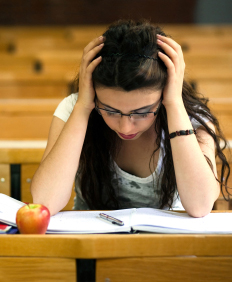Maths in a minute: Simpson's paradox
Suppose you're trying to decide which university to go to. You find out that last year the university you're interested in admitted 30% of male applicants but only 21.3% of female applicants. Looks like a clear case of gender bias, so you're tempted to go somewhere else. But then you look at the figures again, this time broken up by department. The university only has two departments, maths and English. The English department admitted 40% of male applicants and 42% of female applicants. The maths department admitted 10% of male applicants and 11% of female applicants. So if you look at the figures by department, if anything there's bias in favour of women. What's going on?

This is an example of Simpson's paradox, which arises when you look at percentages without giving the actual numbers involved. Suppose the English department admits quite a high proportion of applicants, while the maths department is more choosy and admits only a small proportion. Now suppose that most of the male applicants apply to the English department. Then this drives up the overall percentage of successful male applicants, as English is easier to get into. Similarly, if most women apply to the maths department, then this lowers the overall percentage of successful women applicants, because maths is harder to get into. So it can happen that, although neither department discriminates against women, the overall percentage of successful female applicants is lower than that for males.
Let's go back to the example: suppose that 100 men apply to the English department, so that means that 40 of them got in (40%). Suppose that only 50 women applied to the English department, so 21 of them got in (42%). Suppose the maths department had only 50 male applicants, so 5 got in (10%), and 100 female applicants, of which 11 got in (11%). Then the overall proportion of male applicants who were successful is 45/150 corresponding to 30%. For the women the overall proportion is 32/150 corresponding to 21.3%. Mystery solved.
This paradox isn't just a theoretical curiosity. In 1973 The University of California at Berkeley was sued for sex bias on the basis of figures that were an illustration of Simpson's paradox. It turned out that on the whole women had applied to more competitive departments and that's how the seemingly biased figures arose.
You can find out more about Simpson's paradox on Plus.
Anonymous
What I think about "Simpson's paradox":
http://www.youtube.com/watch?v=KBiSduDfK0o
math.nights
To Arabic: https://goo.gl/sQHJE0
Kilr Panda
So pretty much, from what i see, this is just a manipulation of statistics. not really a paradox. It doesn't defy logic if you look at the stuff behind the results
Elie
Paradoxes don't defy logic when you fully understand them.
Maybe we could call it a fallacy instead. But whatever it's called, people need to understand it, to prevent stupid political decisions :)